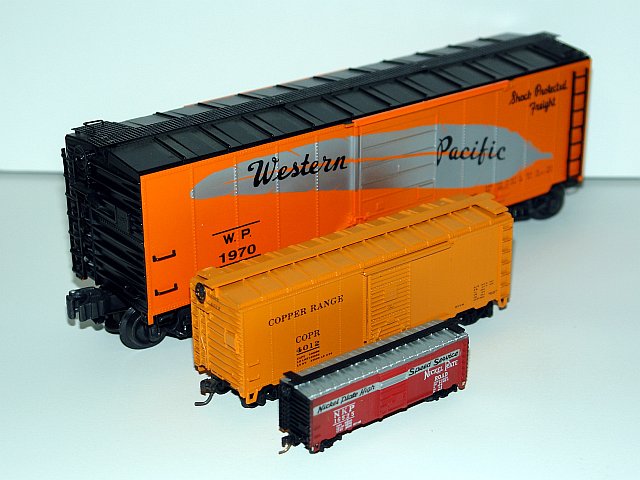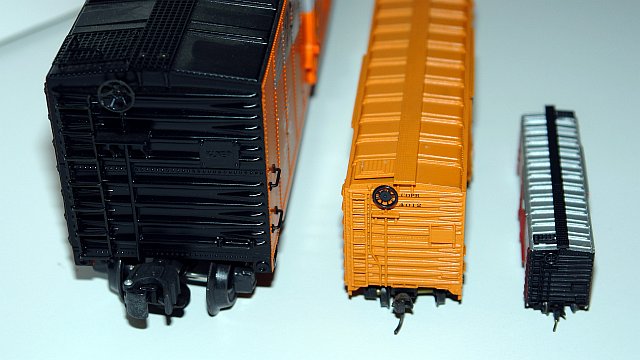Model Railroad Scales
To aid in choosing scale, we've created this article. It'll show the difference in size, space needed, and approximate cost
There are many scales to choose from. All have the distinct advantages & disadvantages. To help you weigh your options, we've created this article to show the differences.

The basic scales to model in are as follows:
| Scale/Gauge: | Inch/MM to 12": | Proportion(s): |
| G gauge | ||
| O27 gauge (Tin plate/3 Rail) | ||
| 0(17) Scale | .266"(6.75mm) | 1:45.2 |
| O,On3,On2 scale | .250"(6.35mm) | 1:48 |
| S,Sn3 scale | .188"(4.76mm) | 1:64 |
| OO scale | 4.0mm(.1575") | 1:76.2 |
| HO,HOn3,HOn2 scale | 3.5mm(.1378") | 1:87.1 |
| TT, TTn3 scale | .100"(2.54mm) | 1:120 |
| N, Nn3 scale | .075"(1.90mm) | 1:160 |
| Z scale | .055"(1.39mm) | 1:220 |

40' Boxcars.
Left to right: O, HO, N.
When choosing a scale, its important to remember, that the larger the number in the proportions, the smaller the model will be. For instance, HO, is 1:87.1, or about half the size of O at 1:48.
When referring to a narrow gauge railroad, it'll be common to see "n3" or in the case of O scale there's "n3", "n2" & "n30" The the refers to narrow, and the trailing number refers to the gauge (width) of the tracks. So, HOn3 would be HO scale, 3' narrow gauge; On30 would be O scale, 30" narrow gauge; On2 would be O scale, 2' narrow gauge.
The stronger supported scales are HO, N & O (more support - to less). This does not mane the other scales are bad, or uncommon in any way. It just means that those scales have a larger commercial manufacturer presence, thus making it slightly easier to find.
Space becomes a large concern when picking a scale. It's important to pick a scale that will work well in the space you have. It's not very smart to choose O scale, if you only have a 1' wide shelf to use, ect.
| Scale: | Our recommended tightest turn radius: | Sectional radius available: |
| O | ||
| S | ||
| HO | 22" | 15", 18", 22", 24", 28" |
| N | ||
| Z |
OO scale has been left out, it uses HO track. Other scales, may be missing, I'll fill in what I can later.
The radius recommended for tightest, is a generous number, that allows for the greatest of option for equipment use. The tighter the radius, the shorter the equipment needs to be.
©2011/2020, https://www.modelrailroadtips.com

